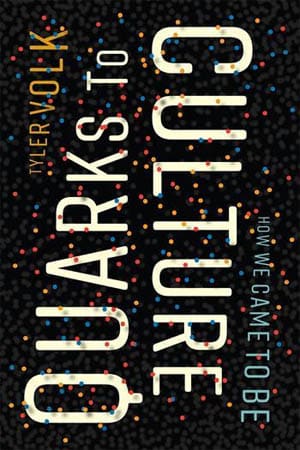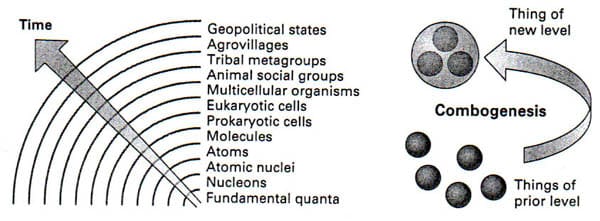
‘Quarks to Culture’ is an important but flawed account of emergence in history, of 12 major transitions that created the world we live in, from the Big Bang to the Geopolitical State.
Tyler Volk
QUARKS TO CULTURE
How we came to be
Columbia University Press, 2017
reviewed by Ian Angus
For mainstream social scientists and academic philosophers, it’s mysticism or a Marxist heresy, but in the natural sciences the idea of change by qualitative leaps — revolutions! — is now widely accepted. The scientists certainly aren’t committed to historical materialism, but the concept of emergence has truly radical implications. Its essence is the dialectical principle that the whole is greater than its parts — that gradual changes can lead to leaps which produce entirely new properties and things that cannot be fully explained by or reduced to the previously-existing components.
Books such as The Emergence of Everything by Harold Morowitz, Revolutions That Made the Earth by Tim Lenton and Andrew Weston, and The Origins of Everything by David Bercovici are valuable introductions to emergent developments in the history of the universe and the Earth.
Quarks to Culture: How We Came to Be, by environmental biologist Tyler Volk, is an important but flawed addition to that genre. It’s a concise and clearly written account of the “specific categories of emergence” that constitute a “path of the construction and creation of things from the simplest particles to us.”
Throughout, Volk attempts to fit everything into an idiosyncratic variant of emergence theory that he calls combogenesis. In my view this weakens his account, particularly when he tries to squeeze the origins and development of human society into a framework that just doesn’t apply. His overview of 14 billion years of revolutionary changes is well worth reading, but his account of humanity’s short part in that history misses the mark.
* * * * *
Emergence literature often refers to a hierarchy of levels, each one above the previous one, but Volk prefers to say the levels are nested, avoiding value-laden terms like higher and lower. In his view, 12 major revolutions have shaped 14 billion years of history. In each case, components of one level — subatomic particles, the elements, the genetic code, etc. — combined to produce something completely new and different. Together they constitute what he names the grand sequence.

Physical Laws: From the big bang through the formation of the basic building blocks of matter. (1) Quarks; (2) Protons and neutrons; (3) Atomic nuclei; (4) Atoms (5) Molecules. Biological evolution: From the origin of life through the emergence of animals that cooperate to survive. (6) Prokaryotic cells; (7) Eukaryotic cells; (8) Multicellular organisms; (9) Animal social groups. Cultural evolution: From networks of tribes of Homo sapiens to states and kingdoms. (10) Tribal metagroups; (11) Agrovillages; (12) Geopolitical states. |
Volk calls this process combogenesis — genesis by combination — a new word he differentiates from emergence by saying it only applies to the transitions between his 12 major levels, not to qualitative changes within those levels. Combogenesis isn’t just a neologism; it is, in his view, a unified framework that explains physical, biological and cultural evolution through the 14 billion years since the birth of the universe.
Volk devotes a chapter to each of the 12 levels, drawing on cosmology, physics, chemistry, geology, biology, evolution and other fields to explain how the level emerged from the previous level, and what its new and unique characteristics were. Those accounts are generally well presented and informative, but in my view the combogenesis framework is more hindrance than help, especially in his discussion of cultural change.
Emergent Life
His account of biological evolution is particularly well done. Level 6, for example, discusses what is known about the origin of cells, and thus about the origin of life. He addresses the still unresolved question of how ordinary chemistry gave rise to replicative chemistry around 3.5 billion years ago.
“Life as we know it requires sophisticated replicative chemistry, with genetics or ribosome nanomachines for assembling amino acids into proteins, energy molecules that use phosphorus, cell membranes, and all else that cells universally have. But early on there must have been, so the logic goes, transitional biochemical steps. And at the final threshold to recognizable life, there emerged from this complex biochemistry the hypothesized LUCA, or ‘last universal common ancestor’ — the ur-cell, progenitor of all current cells today.”
A truly radical innovation was metabolism, the exchange and transformation of energy and matter. Unlike non-living matter, cells cannot exist unless they acquire nutrients and energy from their surroundings, and excrete waste products. As Volk writes, “these inputs and outputs are revolutionary new relations.” Simply by being alive, the newly emerged cells constantly changed themselves and the world around them, literally driving biological evolution by forcing themselves and others to adapt. The existence of life led inexorably to new forms of life.
The next revolution occurred a billion or more years after life emerged. Until then, all living things were prokaryotes — single-celled bacteria or archaea with no nucleus. Then a bacterium entered an archaean cell and an organism with characteristics of both emerged. Of course bacteria and archaea still exist in uncountable numbers, but the product of that symbiotic combination, a eukaryote, was larger, more complex, and used much more energy to survive. Every cell in every other kind of living thing, from amoebas to algae to elephants, is descended from that first combined organism.
Then came communities of cells, leading in time to true multicellular organisms. These required a new kind of metabolism, in which various cells gave up some functions and specialized in others, cooperatively maintaining a being that was bigger than and profoundly different from any of them. Biologist Lewis Thomas wasn’t joking when he wrote that “the most fundamental aspect of nature” is the committee.[1]
Each of these changes was a revolution. At each stage something entirely new emerged: today, all animals and plants are composed of cells, but each is more than the sum of its parts. As Volk notes, when we go down through the levels — from organism to cells to molecules to atoms to subatomic particles — we are also going back through time, to previous stages in the emergence of our world.
Emergent culture?
After his discussion of biological evolution ends with animal social groups (corals, ants and bees, wolf packs), he turns to cultural evolution, leaping ahead to “tribal metagroups,” the dispersed networks of tribes of Homo sapiens, more commonly called clans, that appeared hundreds of millions of years later.
That’s an odd leap, not only because it bypasses hundreds of millions of years of animal and plant evolution, but because it skips over a critically important development in global history — the emergence of hominids who made and used tools, two million years before Homo sapiens arrived. As Harold Morowitz writes, “the growth of toolmaking has been a constant feature from Homo habilis onward. … Hominid evolution can be mapped onto the emergence of toolmaking. They may not be independent emergences.”[2]
Stone toolmaking was a communal activity, performed by groups of hominids who taught each other the difficult skills involved, a practice that encouraged language and brain development. Other animals occasionally use natural objects as tools, but hominids came to depend on deliberately manufactured tools for survival, and that marked a qualitative change in their metabolic relationship with the rest of nature. As Marx and Engels wrote, humans differ from other animals in many ways, but historically “they begin to distinguish themselves from animals as soon as they begin to produce their means of subsistence.”[3] A grand sequence that doesn’t identify the toolmakers as a major new level is surely incomplete, but Volk only mentions toolmaking in passing, as an activity of metagroups, long after the hominid revolutionaries were extinct.
He then turns to agrovillages, his term for settled agricultural communities. The shift from hunting to agriculture is extremely important — archaeologists used to call it the Neolithic revolution, and I’m not convinced that Volk’s label is an improvement. Still, his brief but informative account of the domestication of plants and animals is the best of his cultural evolution chapters. He doesn’t use the phrase, but what he describes was another metabolic revolution.
“The result was a new kind of control on the input of energy to the human cultural system. The origins of this control heralded a new relationship gained by humans with respect to the capture of energy from the environment. Biological food energy did not have to be gathered from wild forging sites of ‘outside’ plants. Instead, with agriculture the primary energy input was the sunlight itself. With agriculture, the sunlight was converted into food energy by the green fields of crops now ‘inside’ the cultural system.”
Agrovillages give way to geopolitical states, his term for the large, centrally governed societies that emerged independently of each other in at least six parts of the world between 5500 and 2100 years ago. He bases his account on Kent Flannery and Joyce Marcus’s impressive book The Creation of Inequality, from which he draws a handful of key points.
And then the grand sequence stops — in his view there has been no further combogenesis since the Bronze Age. The idea that there is no qualitative difference between the Zapotec society at Monte Albán in 100 BCE and the U.S. global empire headed by Donald Trump will strike most readers as ludicrous, but there it is. The emergence of capitalism and imperialism, the immense metabolic shift to energy from fossil fuels, the great acceleration and the Anthropocene — none of these qualifies for the grand sequence. Instead he leaves us with speculations about a future “emerging planetary level” and a call to “actively sculpt a concept of personal enlightenment.”
Combogenesis has clouded his vision.
Major omissions
Hominid toolmakers aren’t the only major omission in Volk’s grand sequence of emergent levels.
Another is what’s been called the “great oxygenation event.” For most of Earth’s history, oxygen was a tiny fraction of the Earth’s atmosphere. In a short time, geologically speaking, cells that lived by photosynthesis raised that to today’s 21 percent. The change may be related to reduced volcanic activity, or to the 100-million year period known as Snowball Earth, when the planet’s entire surface was covered in ice. Whatever the causes, it was one of the greatest revolutions in earth system history: without it, the emergence and rapid spread of multi-cellular life might never have occurred. In addition to making higher-energy metabolisms possible, it created the ozone layer that protects all life from deadly radiation. Although Volk has previously described this revolution in another book, he omits it from the grand sequence in Quarks to Culture.[4]
I could list other omissions: in his 2002 book The Emergence of Everything, biophysicist Harold J. Morowitz identified and described “28 examples of emergence … selected to form an almost linear chronological sequence from the beginning of the universe.”[5] Among others, he included the emergence of stars, solar systems, planets, neurons, vertebrates, and language, none of which appear on Volk’s list.
Of course any selection is arbitrary, and I’m far from endorsing Morowitz’s sequence, which he presented as our path to a transcendent and immanent God. But what strikes me is that Volk consistently omits emergences that don’t fit his combogenesis model in which “prior things change when they merge into larger things.” Hominid toolmaking communities were smaller than previous animal groups, and the oxygen revolution, a function of the entire Earth system, couldn’t possibly fit between layers in the grand sequence.
It seems that his model, which should help to understand the history of our world, at some point became a barrier that excludes major parts of that history from consideration. Cart and horse are reversed.
His account of cultural evolution has a related but more serious problem. Change in the physical and biological realms is determined by the impersonal physical and biological laws that apply at those levels. But when toolmaking humans evolved, the nature of change changed. Physical laws and instinct still play a role, but as archaeologist V. Gordon Childe wrote in his discussion of the differences between organic and social evolution, in human societies “changes … can be initiated, controlled, or delayed by the conscious and deliberate choice of their human authors and executors.”[6] Of course, human choices are often stymied by unexpected consequences, and free will is not unlimited, but the process of change cannot be explained by biological laws. If Volk can’t find combogenesis in our time, despite unprecedented global change, it is because the dynamics of human social change are beyond his model’s scope.

First edition of The Long View of History, published in 1960 under George Novack’s pen-name, William F. Warde
The VERY long view of history
My introduction to historical materialism, decades ago, was The Long View of History, by the American socialist educator George Novack — he described it as “a popularized account of evolution from the fish to humankind … an extremely simplified outline of that immense and intricate evolutionary process.”[7] It wasn’t his best work — much of the science was already out-of-date when it was published, and the historical account was schematic — but I remember being particularly impressed by his insistence that “the movement based upon scientific socialism, which prepares most energetically for the future, likewise must probe most deeply into the past.”
I’d very much like to see a twenty-first century counterpart of Novack’s pamphlet, a major essay or book that brings together contemporary natural scientific research and the latest Marxist social analysis in a modern very long view of history. Quarks to Culture isn’t that book, but it is one of the best popular books on emergence in history. Combogenesis is not the universal theory of change Tyler Volk promises, but if you want an overview of how our world emerged then his account of 14 billion years of revolutionary change is a pretty good place to start.
[1] Lewis Thomas, The Medusa and the Snail (New York, Viking Press: 1979), 13.
[2] Harold J. Morowitz, The Emergence of Everything (London, Oxford University Press: 2002), 156-7. Some other animals use tools on a limited basis, but only the genus homo uses tools to make tools, uses them consistently, and has based entire societies on the results of that use.
[3] Karl Marx and Frederick Engels, The German Ideology [1845]. Emphasis added.
[4] Tyler Volk, Gaia’s Body (Cambridge: MIT Press, 2003), 227-30.
[5] Morowitz, Emergence, 25.
[6] V. Gordon Childe, Man Makes Himself (New York: New American Library, 1951), 21.
[7] George Novack, Understanding History: Marxist Essays (New York: Pathfinder Press, 1972), 6.


